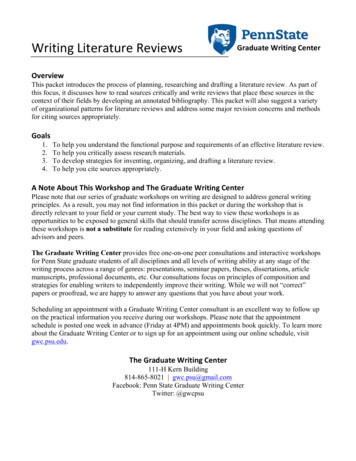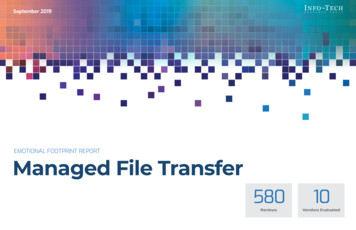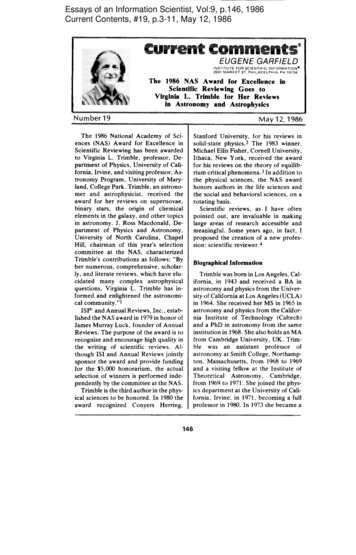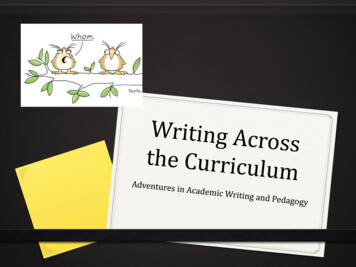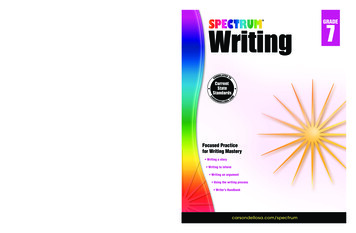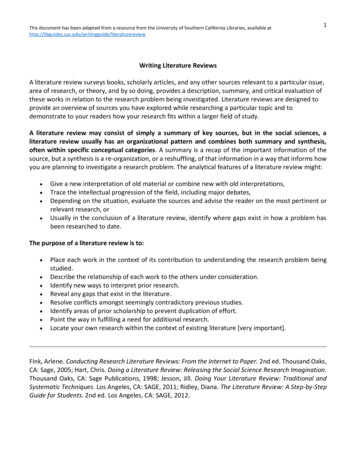
Transcription
This document has been adapted from a resource from the University of Southern California Libraries, available review1Writing Literature ReviewsA literature review surveys books, scholarly articles, and any other sources relevant to a particular issue,area of research, or theory, and by so doing, provides a description, summary, and critical evaluation ofthese works in relation to the research problem being investigated. Literature reviews are designed toprovide an overview of sources you have explored while researching a particular topic and todemonstrate to your readers how your research fits within a larger field of study.A literature review may consist of simply a summary of key sources, but in the social sciences, aliterature review usually has an organizational pattern and combines both summary and synthesis,often within specific conceptual categories. A summary is a recap of the important information of thesource, but a synthesis is a re-organization, or a reshuffling, of that information in a way that informs howyou are planning to investigate a research problem. The analytical features of a literature review might: Give a new interpretation of old material or combine new with old interpretations,Trace the intellectual progression of the field, including major debates,Depending on the situation, evaluate the sources and advise the reader on the most pertinent orrelevant research, orUsually in the conclusion of a literature review, identify where gaps exist in how a problem hasbeen researched to date.The purpose of a literature review is to: Place each work in the context of its contribution to understanding the research problem beingstudied.Describe the relationship of each work to the others under consideration.Identify new ways to interpret prior research.Reveal any gaps that exist in the literature.Resolve conflicts amongst seemingly contradictory previous studies.Identify areas of prior scholarship to prevent duplication of effort.Point the way in fulfilling a need for additional research.Locate your own research within the context of existing literature [very important].Fink, Arlene. Conducting Research Literature Reviews: From the Internet to Paper. 2nd ed. Thousand Oaks,CA: Sage, 2005; Hart, Chris. Doing a Literature Review: Releasing the Social Science Research Imagination.Thousand Oaks, CA: Sage Publications, 1998; Jesson, Jill. Doing Your Literature Review: Traditional andSystematic Techniques. Los Angeles, CA: SAGE, 2011; Ridley, Diana. The Literature Review: A Step-by-StepGuide for Students. 2nd ed. Los Angeles, CA: SAGE, 2012.
This document has been adapted from a resource from the University of Southern California Libraries, available review2Types of Literature ReviewsIt is important to think of knowledge in a given field as consisting of three layers. First, there are theprimary studies that researchers conduct and publish. Second are the reviews of those studies thatsummarize and offer new interpretations built from and often extending beyond the primary studies.Third, there are the perceptions, conclusions, opinion, and interpretations that are shared informally thatbecome part of the lore of field.In composing a literature review, it is important to note that it is often this third layer of knowledge thatis cited as "true" even though it often has only a loose relationship to the primary studies and secondaryliterature reviews. Given this, while literature reviews are designed to provide an overview and synthesisof pertinent sources you have explored, there are a number of approaches you could adopt dependingupon the type of analysis underpinning your study.Types of Literature ReviewsArgumentative ReviewThis form examines literature selectively in order to support or refute an argument, deeply imbeddedassumption, or philosophical problem already established in the literature. The purpose is to develop abody of literature that establishes a contrarian viewpoint. Given the value-laden nature of some socialscience research [e.g., educational reform; immigration control], argumentative approaches to analyzingthe literature can be a legitimate and important form of discourse. However, note that they can alsointroduce problems of bias when they are used to make summary claims of the sort found in systematicreviews [see below].Integrative ReviewConsidered a form of research that reviews, critiques, and synthesizes representative literature on atopic in an integrated way such that new frameworks and perspectives on the topic are generated. Thebody of literature includes all studies that address related or identical hypotheses or research problems.A well-done integrative review meets the same standards as primary research in regard to clarity, rigor,and replication. This is the most common form of review in the social sciences.Historical ReviewFew things rest in isolation from historical precedent. Historical literature reviews focus on examiningresearch throughout a period of time, often starting with the first time an issue, concept, theory,phenomena emerged in the literature, then tracing its evolution within the scholarship of a discipline.The purpose is to place research in a historical context to show familiarity with state-of-the-artdevelopments and to identify the likely directions for future research.Methodological ReviewA review does not always focus on what someone said [findings], but how they came about saying whatthey say [method of analysis]. Reviewing methods of analysis provides a framework of understanding atdifferent levels [i.e. those of theory, substantive fields, research approaches, and data collection and
This document has been adapted from a resource from the University of Southern California Libraries, available review3analysis techniques], how researchers draw upon a wide variety of knowledge ranging from theconceptual level to practical documents for use in fieldwork in the areas of ontological andepistemological consideration, quantitative and qualitative integration, sampling, interviewing, datacollection, and data analysis. This approach helps highlight ethical issues which you should be aware ofand consider as you go through your own study.Systematic ReviewThis form consists of an overview of existing evidence pertinent to a clearly formulated researchquestion, which uses pre-specified and standardized methods to identify and critically appraise relevantresearch, and to collect, report, and analyze data from the studies that are included in the review.Typically it focuses on a very specific empirical question, often posed in a cause-and-effect form, such as"To what extent does A contribute to B?"Theoretical ReviewThe purpose of this form is to examine the corpus of theory that has accumulated in regard to an issue,concept, theory, phenomena. The theoretical literature review helps to establish what theories alreadyexist, the relationships between them, to what degree the existing theories have been investigated, andto develop new hypotheses to be tested. Often this form is used to help establish a lack of appropriatetheories or reveal that current theories are inadequate for explaining new or emerging researchproblems. The unit of analysis can focus on a theoretical concept or a whole theory or framework.Baumeister, Roy F. and Mark R. Leary. "Writing Narrative Literature Reviews." Review of GeneralPsychology 1 (September 1997): 311-320; Mark R. Fink, Arlene. Conducting Research Literature Reviews:From the Internet to Paper. 2nd ed. Thousand Oaks, CA: Sage, 2005; Hart, Chris. Doing a Literature Review:Releasing the Social Science Research Imagination. Thousand Oaks, CA: Sage Publications, 1998; Kennedy,Mary M. "Defining a Literature." Educational Researcher 36 (April 2007): 139-147; Petticrew, Mark andHelen Roberts. Systematic Reviews in the Social Sciences: A Practical Guide. Malden, MA: Blackwell, 2006;Torracro, Richard. "Writing Integrative Literature Reviews: Guidelines and Examples." Human ResourceDevelopment Review 4 (September 2005): 356-367; Rocco, Tonette S. and Maria S. Plakhotnik. "LiteratureReviews, Conceptual Frameworks, and Theoretical Frameworks: Terms, Functions, and Distinctions."Human Ressource Development Review 8 (March 2008): 120-130.
This document has been adapted from a resource from the University of Southern California Libraries, available review4Structure and Writing StyleI. Thinking About Your Literature ReviewThe structure of a literature review should include the following: An overview of the subject, issue, or theory under consideration, along with the objectives of theliterature review,Division of works under review into themes or categories [e.g. works that support a particularposition, those against, and those offering alternative approaches entirely],An explanation of how each work is similar to and how it varies from the others,Conclusions as to which pieces are best considered in their argument, are most convincing of theiropinions, and make the greatest contribution to the understanding and development of their areaof research.The critical evaluation of each work should consider: Provenance -- what are the author's credentials? Are the author's arguments supported byevidence [e.g. primary historical material, case studies, narratives, statistics, recent scientificfindings]?Methodology -- were the techniques used to identify, gather, and analyze the data appropriate toaddressing the research problem? Was the sample size appropriate? Were the results effectivelyinterpreted and reported?Objectivity -- is the author's perspective even-handed or prejudicial? Is contrary data consideredor is certain pertinent information ignored to prove the author's point?Persuasiveness -- which of the author's theses are most convincing or least convincing?Value -- are the author's arguments and conclusions convincing? Does the work ultimatelycontribute in any significant way to an understanding of the subject?II. Development of the Literature ReviewFour Stages1. Problem formulation -- which topic or field is being examined and what are its component issues?2. Literature search -- finding materials relevant to the subject being explored.3. Data evaluation -- determining which literature makes a significant contribution to the understandingof the topic.4. Analysis and interpretation -- discussing the findings and conclusions of pertinent literature.Consider the following issues before writing the literature review:
This document has been adapted from a resource from the University of Southern California Libraries, available review5ClarifyIf your assignment is not very specific about what form your literature review should take, seekclarification from your professor by asking these questions:1. Roughly how many sources should I include?2. What types of sources should I review (books, journal articles, websites; scholarly versus popularsources)?3. Should I summarize, synthesize, or critique sources by discussing a common theme or issue?4. Should I evaluate the sources?5. Should I provide subheadings and other background information, such as definitions and/or ahistory?Find ModelsUse the exercise of reviewing the literature to examine how authors in your discipline or area of interesthave composed their literature review sections. Read them to get a sense of the types of themes youmight want to look for in your own research or to identify ways to organize your final review. Thebibliography or reference section of sources you've already read are also excellent entry points into yourown research.Narrow the TopicThe narrower your topic, the easier it will be to limit the number of sources you need to read in order toobtain a good survey of relevant resources. Your professor will probably not expect you to readeverything that's available about the topic, but you'll make your job easier if you first limit scope of theresearch problem. A good strategy is to begin by searching library resources for books about the topicand review the table of contents for chapters that focuses on specific issues. You can also review theindexes of books to find references to specific issues that can serve as the focus of your research. Forexample, a book surveying the history of the Israeli-Palestinian conflict may include a chapter on the roleEgypt has played in mediating the conflict, or look in the index for the pages where Egypt is mentionedin the text.Consider Whether Your Sources are CurrentSome disciplines require that you use information that is as current as possible. This is particularly truein disciplines in medicine and the sciences where research conducted becomes obsolete very quickly asnew discoveries are made. However, when writing a review in the social sciences, a survey of the historyof the literature may be required. In other words, a complete understanding the research problemrequires you to deliberately examine how knowledge and perspectives have changed over time. Sortthrough other current bibliographies or literature reviews in the field to get a sense of what yourdiscipline expects. You can also use this method to explore what is considered by scholars to be a "hottopic" and what is not.
This document has been adapted from a resource from the University of Southern California Libraries, available review6III. Ways to Organize Your Literature ReviewChronologicalIf your review follows the chronological method, you could write about the materials according to whenthey were published. This approach should only be followed if a clear path of research building onprevious research can be identified and that these trends follow a clear chronological order ofdevelopment. For example, a literature review that focuses on continuing research about theemergence of German economic power after the fall of the Soviet Union.By PublicationOrder your sources by publication chronology, then, only if the order demonstrates a more importanttrend. For instance, you could order a review of literature on environmental studies of brown fields ifthe progression revealed, for example, a change in the soil collection practices of the researchers whowrote and/or conducted the studies.Thematic [“conceptual categories”]Thematic reviews of literature are organized around a topic or issue, rather than the progression oftime. However, progression of time may still be an important factor in a thematic review. For example, areview of the Internet’s impact on American presidential politics could focus on the development ofonline political satire. While the study focuses on one topic, the Internet’s impact on Americanpresidential politics, it will still be organized chronologically reflecting technological developments inmedia. The only difference here between a "chronological" and a "thematic" approach is what isemphasized the most: the role of the Internet in presidential politics. Note however that more authenticthematic reviews tend to break away from chronological order. A review organized in this manner wouldshift between time periods within each section according to the point made.MethodologicalA methodological approach focuses on the methods utilized by the researcher. For the Internet inAmerican presidential politics project, one methodological approach would be to look at culturaldifferences between the portrayal of American presidents on American, British, and French websites. Orthe review might focus on the fundraising impact of the Internet on a particular political party. Amethodological scope will influence either the types of documents in the review or the way in whichthese documents are discussed.Other Sections of Your Literature ReviewOnce you've decided on the organizational method for your literature review, the sections you need toinclude in the paper should be easy to figure out because they arise from your organizational strategy. Inother words, a chronological review would have subsections for each vital time period; a thematicreview would have subtopics based upon factors that relate to the theme or issue. However, sometimesyou may need to add additional sections that are necessary for your study, but do not fit in the
This document has been adapted from a resource from the University of Southern California Libraries, available review7organizational strategy of the body. What other sections you include in the body is up to you but includeonly what is necessary for the reader to locate your study within the larger scholarship framework.Here are examples of other sections you may need to include depending on the type of review you write: Current Situation: information necessary to understand the topic or focus of the literature review.History: the chronological progression of the field, the literature, or an idea that is necessary tounderstand the literature review, if the body of the literature review is not already a chronology.Selection Methods: the criteria you used to select (and perhaps exclude) sources in your literaturereview. For instance, you might explain that your review includes only peer-reviewed articles andjournals.Standards: the way in which you present your information.Questions for Further Research: What questions about the field has the review sparked? How willyou further your research as a result of the review?IV. Writing Your Literature ReviewOnce you've settled on how to organize your literature review, you're ready to write each section. Whenwriting your review, keep in mind these issues.Use EvidenceA literature review section is, in this sense, just like any other academic research paper. Yourinterpretation of the available sources must be backed up with evidence [citations] that demonstratesthat what you are saying is valid.Be SelectiveSelect only the most important points in each source to highlight in the review. The type of informationyou choose to mention should relate directly to the research problem, whether it is thematic,methodological, or chronological. Related items that provide additional information but that are not keyto understanding the research problem can be included in a list of further readings.Use Quotes SparinglySome short quotes are okay if you want to emphasize a point, or if what an author stated cannot beeasily paraphrased. Sometimes you may need to quote certain terminology that was coined by theauthor, not common knowledge, or taken directly from the study. Do not use extensive quotes as asubstitute for your own summary and interpretation of the literature.Summarize and SynthesizeRemember to summarize and synthesize your sources within each thematic paragraph as well asthroughout the review. Recapitulate important features of a research study, but then synthesize it byrephrasing the study's significance and relating it to your own work.
This document has been adapted from a resource from the University of Southern California Libraries, available review8Keep Your Own VoiceWhile the literature review presents others' ideas, your voice [the writer's] should remain front andcenter. For example, weave references to other sources into what you are writing but maintain yourown voice by starting and ending the paragraph with your own ideas and wording.Use Caution When ParaphrasingWhen paraphrasing a source that is not your own, be sure to represent the author's information oropinions accurately and in your own words. Even when paraphrasing an author’s work, you still mustprovide a citation to that work.V. Common Mistakes to AvoidThese are the most common mistakes made in reviewing social science research literature. Sources in your literature review do not clearly relate to the research problem;You do not take sufficient time to define and identify the most relevant sources to use in theliterature review related to the research problem;Relies exclusively on secondary analytical sources rather than including relevant primary researchstudies or data;Uncritically accepts another researcher's findings and interpretations as valid, rather thanexamining critically all aspects of the research design and analysis;Does not say how literature is “bounded” or describe the search procedures that were used inidentifying the literature to review (but seems to imply review is exhaustive);Reports isolated statistical results rather than synthesizing them in chi-squared or meta-analyticmethods; and,Only includes research that validates assumptions and does not consider contrary findings andalternative interpretations found in the literature.Cook, Kathleen E. and Elise Murowchick. “Do Literature Review Skills Transfer from One Course toAnother?” Psychology Learning and Teaching 13 (March 2014): 3-11; Fink, Arlene. Conducting ResearchLiterature Reviews: From the Internet to Paper. 2nd ed. Thousand Oaks, CA: Sage, 2005; Hart, Chris. Doinga Literature Review: Releasing the Social Science Research Imagination. Thousand Oaks, CA: SagePublications, 1998; Jesson, Jill. Doing Your Literature Review: Traditional and Systematic Techniques.London: SAGE, 2011; Literature Review Handout. Online Writing Center. Liberty University; LiteratureReviews. The Writing Center. University of North Carolina; Ridley, Diana. The Literature Review: A Stepby-Step Guide for Students. 2nd ed. Los Angeles, CA: SAGE, 2012; Randolph, Justus J. “A Guide to Writingthe Dissertation Literature Review." Practical Assessment, Research, and Evaluation. vol. 14, June 2009;Taylor, Dena. The Literature Review: A Few Tips On Conducting It. University College Writing Centre.University of Toronto; Writing a Literature Review. Academic Skills Centre. University of Canberra.
Writing Literature Reviews A literature review surveys books, scholarly articles, and any other sources relevant to a particular issue, area of research, or theory, and by so doing, provides a description, summary, and critical evaluation of . Conducting Research Literature Reviews: From the Internet to Paper. 2nd ed. Thousand Oaks, CA: Sage .
